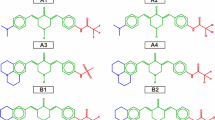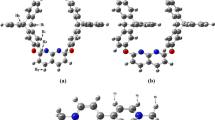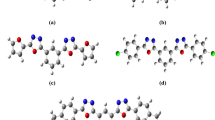Abstract
This study investigates the supramolecular interactions between perylene diimides (PDI) and nucleotides, specifically adenosine monophosphate (AMP) and cytidine monophosphate (CMP). Ten complexes (complex 1 (l-ala-PDI-AMP), complex 2 (B-ala-PDI-AMP), complex 3 (GLY-PDI-AMP), complex 4 (IMI-PDI-AMP), complex 5 (PYR-PDI-AMP, complex 6 (l-ala-PDI-CMP), complex 7 (B-ala-PDI-CMP), complex 8 (GLY-PDI-CMP), complex 9 (IMI-PDI-CMP), and complex 10 (PYR-PDI-CMP), were simulated using the B3LYP/6-31G(d,p) level of DFT method. The study explores NMR, IR, UV, hyperpolarizabilities, frontier molecular orbitals (FMOs), density of states (DOS), noncovalent interactions (NCI), iso-surface analysis, atom in molecule (AIM), dipole moment (µ), electron density distribution map (EDDM), transition density matrix (TDM), molecular electrostatic potential (MEP), and electron–hole analysis (EHA) using differential functional theory (DFT). The weak bonds formed were visualized using Discovery Studio Visualizer. The electronic properties of the complexes were examined through natural bond orbital (NBO) and natural population analysis (NPA), leading to nonlinear optics (NLO) study. Complex 6 demonstrates the highest NLO activity with γ static of 17,424,700.00, and complex 10 exhibits the weakest NLO activity with second dipole hyperpolarizability (γ static) at 25,116.10. Moreover, global reactivity factors for complexes 1–5 show EA ranging from 6.53 to 7.7, and ionization potential (IP) spans 7.8–8.8. Global hardness values highlight complex 4 as the hardest (η = 0.55) and complex 1 as the softest (η = 0.51). Electronegativity (X) varies from 7.28 to 8.25, with complex 3 being the most electronegative. Chemical potential (μ) ranges from − 7.9 to − 8.25, global softness (σ) identifies complex 1 as the softest (0.2575) and complex 4 as the hardest (0.435). Electrophilicity (ω) ranges from 33.30 to 61.87. Complexes 6–10 show EA from 6.7 to 7.53. IP values range from 8.4 to 8.6, with complexes 7 and 10 highest. Global hardness spans 0.53 to 0.85. X ranges from 7.55 to 8.06, with complex 7 the most electronegative. μ varies from − 7.55 to − 8.06, and complex 7 has the lowest. From σ values, complexes 9 and 10 are the softest. ω ranges from 35.53 to 60.78, with complex 7 the most electrophilic.
























Similar content being viewed by others
References
Kennedy CR, Lin S, Jacobsen EN (2016) The cation–π interaction in small-molecule catalysis. Angew Chem Int Ed Engl 55:12596–12624
Zhao Y, Cotelle Y, Liu L, López-Andarias J, Bornhof A-B, Akamatsu M, Sakai N, Matile SJ (2018) The emergence of anion–π catalysis. Acc Chem Res 51:2255–2263.
Wheeler SE, Houk KN (2010) Are anion/π interactions actually a case of simple charge–dipole interactions? J Phys Chem A 114:8658–8664
Herbert JMJ (2021) Neat, simple, and wrong: Debunking electrostatic fallacies regarding noncovalent interactions. J Phys Chem A 125:7125–7137
Wheeler SE, Bloom JWJCC (2014) Anion–π interactions and positive electrostatic potentials of N-heterocycles arise from the positions of the nuclei, not changes in the π-electron distribution. Chem Commun 50:11118–11121
Bootsma AN, Wheeler SE (2018) Tuning stacking interactions between asp–arg salt bridges and heterocyclic drug fragments. J Chem Inf Model 59:149–158.
Bootsma AN, Wheeler SE (2019) Converting SMILES to stacking interaction energies. J Chem Inf Model 59:3413–3421.
Wheeler SE, Houk KN (2009) Through-space effects of substituents dominate molecular electrostatic potentials of substituted arenes. J Chem Theory Comput 5:2301–2312
Khan MA, Ayub AR, Alrowaili Z, Ilyas M, Hui L, Abbas SZ (2022) Self-assembly of 2D coordination complex of cytidine monophosphate to boost up the optical phenomena. J Molec Struct 1268:133655
Arshad MN, Faidallah HM, Asiri AM, Kosar N, Mahmood TJ (2020) Structural, spectroscopic and nonlinear optical properties of sulfonamide derivatives; experimental and theoretical study. J Molec Struct 1202:127393
Ling Q-H, Zhu J-L, Qin Y, Xu L (2020) Naphthalene diimide-and perylene diimide-based supramolecular cages. Mater Chem Front 4:3176–3189
Wang R, Ma Y, Zhao J, Zhang A, Yang S, Shen H, Li G, Shi Z (2018) Novel hydroxyl-substituted perylene-3, 4, 9, 10-tetracarboxylic acid diimides for selective recognition of fluoride. Sens Actuators B: Chem 260:719–726
Popova VG, Kulik LV, Samoilova RI, Stass DV, Kokovkin VV, Glebov EM, Berezin AS, Novikov AS, Garcia A, Tuan HT et al (2023) Noncovalent dualism in perylene-diimide-based keggin anion complexes: theoretical and experimental studies. Inorganic Chem 62:19677–19689
Yin H, Geng Y, Sun G-Y, Su Z-M (2017) Theoretical design of perylene diimide dimers with different linkers and bridged positions as promising non-fullerene acceptors for organic photovoltaic cells. J Phys Chem C 121:2125–2134
Rostami-Tapeh-Esmail E, Golshan M, Salami-Kalajahi M, Roghani-Mamaqani H (2020) Perylene-3, 4, 9, 10-tetracarboxylic diimide and its derivatives: Synthesis, properties and bioapplications. Dyes Pigments 180:108488
Frisch M, Trucks G, Schlegel H, Scuseria G, Robb M, Cheeseman J, Scalmani G, Barone V, Mennucci B, Petersson GA (2009) Gaussian 09 Revision A. 1, 2009. 139.
Ali HS, Henchman RH, de Visser SP (2021) What Determines the Selectivity of arginine dihydroxylation by the nonheme iron enzyme OrfP? Chem A Euro J 27:1795–1809
Becke AD (1993) Density‐functional thermochemistry. III. The role of exact exchange. J Chem Phys 98:5648–5652.
Grimme S, Ehrlich S, Goerigk L (2011) Effect of the damping function in dispersion corrected density functional theory. J Comput Chem 32:1456–1465
Yang Z, Liu C, Shao C, Zeng X, Cao DJN (2016) Screening π-conjugated bridges of organic dyes for dye-sensitized solar cells with panchromatic visible light harvesting. Nanotechnology 27(26):265701
Studio DJA (2008) Discovery studio.
Yanai T, Tew DP, Handy NC (2004) A new hybrid exchange–correlation functional using the Coulomb-attenuating method (CAM-B3LYP). Chem Phys Lett 393:51–57
Norman P, Bishop DM, Jensen HJA, Oddershede J (2005) Nonlinear response theory with relaxation: the first-order hyperpolarizability. J Chem Phys 123:194103
Qiu Y-Q, Li Z, Ma N-N, Sun S-L, Zhang M-Y, Liu P-J (2013) Third-order nonlinear optical properties of molecules containing aromatic diimides: effects of the aromatic core size and a redox-switchable modification. J Mol Graph Model 41:79–88.
Gorelsky SJ (2010) SWizard Program. University of Ottawa, Ottawa, p 2013
Lu T, Chen F (2012) Multiwfn: a multifunctional wavefunction analyzer. J Comput Chem 33:580–592
O'boyle NM, Tenderholt AL, Langner KM (2008) Cclib: a library for package‐independent computational chemistry algorithms. J Comput Chem 29:839–845.
Resnati G, Boldyreva E, Bombicz P, Kawano MJI (2015) Supramolecular interactions in the solid state. IUCrJ 2:675–690
Varshey DB, Sander JR, Friščić T, MacGillivray LR (2012) Supramolecular Interactions. In: Steed JW, Gale PA (eds) Supramolecular chemistry: from molecules to nanomaterials. Wiley-VCH, pp 9–24
Sharma S, Sharma A, Gupta U (2021) Molecular Docking studies on the Anti-fungal activity of Allium sativum (Garlic) against Mucormycosis (black fungus) by BIOVIA discovery studio visualizer 21.1. 0.0.
Design LJBC (2014) Pharmacophore and ligand-based design with Biovia Discovery Studio®.
Parr RG, von Szentpály L, Liu SJ (1999) Electrophilicity index. J Amer Chem Soc 121:1922–1924. https://doi.org/10.1021/ja983494x
Chattaraj PK, Roy DR (20070 Update 1 of: electrophilicity index. Chem Rev 107:PR46-PR74.
Parr RG, Donnelly RA, Levy M, Palke WE (1978) Electronegativity: the density functional viewpoint. J Chem Phys 68:3801–3807
Tsuneda T, Song J-W, Suzuki S, Hirao K (2010) On Koopmans’ theorem in density functional theory. J Chem Phys 133:174101
Deepa PJ (2019) Does the stability of the stacking motif surpass the planar motif in 2-amino-4-nitrophenol?—a CCSD (T) analysis. J Mol Model 25:1–9
Das C, Adak P, Mondal S, Sekiya R, Kuroda R, Gorelsky SI, Chattopadhyay SK (2014) Synthesis, characterization, X-ray crystal structure, DFT calculations, and catalytic properties of a dioxidovanadium (V) complex derived from oxamohydrazide and pyridoxal: A model complex of vanadate-dependent bromoperoxidase. Inorg Chem 53:11426–11437
Acknowledgements
This work was financially supported by the National Natural Science Foundation of China (No. 21471017) and the Inter- national Collaboration Project of Ministry of Science and Technology (Grant no. G2022184006L). A. Irfan extends his appreciation to the Deanship of Scientific Research at King Khalid University for funding through Large Group Research Project under Grant No. RGP2/63/44. Y. Sandali thanks the University of Jeddah for its technical and financial support under grant no. (UJ-23-DR-248).
Funding
There is no funding.
Author information
Authors and Affiliations
Contributions
W.H. wrote the manuscript, and done the simulation. S.I. proof read the manuscript. M.R. helped in making figures. M.M. helped in making scheme. H.S. helped in simulation M.H. corrected the English language specifically. H.L . is the group leader (my supervisor, she will be corresponding author), Y.S. helped me in revision. and A.I. helped me in revision too. All authors reviewed the manuscript.
Corresponding author
Ethics declarations
Conflict of interests
There are no conflicts to declare.
Additional information
Publisher's Note
Springer Nature remains neutral with regard to jurisdictional claims in published maps and institutional affiliations.
Supplementary Information
Below is the link to the electronic supplementary material.
Rights and permissions
Springer Nature or its licensor (e.g. a society or other partner) holds exclusive rights to this article under a publishing agreement with the author(s) or other rightsholder(s); author self-archiving of the accepted manuscript version of this article is solely governed by the terms of such publishing agreement and applicable law.
About this article
Cite this article
Hussain, W., Ali, H.S., Iqbal, M.S. et al. Exploring nonlinear optical properties of perylene diimide and biomolecules complexes: a computational supramolecular study. Theor Chem Acc 143, 27 (2024). https://doi.org/10.1007/s00214-024-03098-w
Received:
Accepted:
Published:
DOI: https://doi.org/10.1007/s00214-024-03098-w




